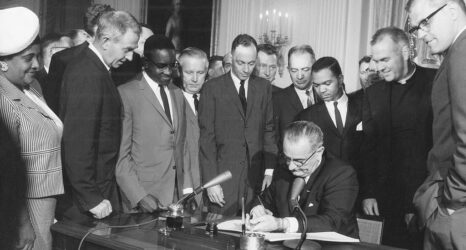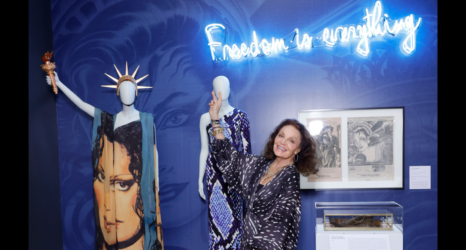As a feminist in the digital age, my exposure to the movement is different than that of my mother’s. A large part of my life is click and scroll. My news feed refreshes every second. There’s a lot happening—and it’s easy to get caught up in the thick of it. Sometimes I need to unplug and seek something else.
That’s how I found The Wing.
The Wing is a co-working space and social community for women in New York City. Established in 2016, the website declares that “women need and deserve a multi-purpose space designed to make their lives easier,” and that “magic is created when women gather together.” While the space is truly designed for modern day — complete with millennial pink furniture and Instagram-friendly wallpaper—it’s rooted in the history of the feminist spaces of yore.
The women’s club movement of the late 19th century and early 20th century unfolded alongside the suffrage movement. Women’s clubs were revolutionary destinations where women could work, gather and learn alongside one another—and, in some cases, plot their next moves in the fight for equality.
Sorosis, formed in 1868 by women journalists who were denied entrance to a New York Press Club event, was recognized as the first women’s club—launched with the intention of having a place for women to “dwell together in unity.” Later the same year, the New England Women’s Club was founded in Boston.
In 1869, alongside the women’s club emergence, Elizabeth Cady Stanton and Susan B. Anthony established the National Woman’s Suffrage Association (NWSA). While these entities were separate in practice, their values and function were tightly akin. Many women’s clubs which were directly involved in civil rights and other various types of reform; there was also a direct correlation between the growth of women’s clubs and the increase in suffrage organizations. And in 1888, the convention of the International Council of Women by NWSA in Washington, D.C. brought women’s clubs, feminist associations and social and political activists together for the cause of equality among the sexes and the overall advancement of women. In the name of universal sisterhood, the Council aimed to “impress the important lesson that the position of women anywhere affects their position everywhere.”
Louise Thomas, president of Sorosis, traveled to the convention alongside the club’s original incorporators and 32 of its members. She addressed the club as a composition of “literary and representative women, who meet for the interchange of thought; to be a help to each other, and to have a good time.”
Julia Ward Howe, president of the Association for the Advancement of Women (later, the General Federation of Women’s Clubs), a superintending body meant to bring women’s clubs toward cohesion, declared at the same convening that “from our coming together much good ought to result.” In her speech, Howe acknowledged the complications and inevitable downfalls in the life of an organization, but praised the work of the women’s clubs in their ability to function successfully and independently and for the great influence they have exerted upon their communities.
While it’s true that many women’s clubs were of a positive influence, and in some ways crucial to the advancement of women’s rights, a legacy of segregation led black reformers to organize their own groups through the 1880s. In 1896, the largest federation of local black women’s clubs, the National Association of Colored Women (NACW) was formed—concerned with the advancement of all people of color.
Independent of the aforementioned clubs and associations, the NACW fought for change beyond suffrage and women’s rights, including ending the segregation of transportation systems and the anti-lynching movement. The association, directed by Mary Church Terrell, also focused on job training, wage equity and childcare. In 1900, nearly every black community had a women’s club. By 1914, there were over a thousand participating clubs in the NACW; these women’s clubs counted among their members some of history’s bravest feminists, including Ida B. Wells and Harriet Tubman.
Today, diversity is an asset. The Wing seeks variety as a primary quality of its members and aims to maintain career diversity as well as ethnic and racial diversity among them. Community and activism are also key principles: The Wing membership agreement has a service requirement to encourage social activism, and they provide many political opportunities to those who join. Last year, The Wing sent 100 women by bus to the Women’s March on Washington; each month, rotating events feature information sessions with organizations like the New York Civil Liberties Union or Planned Parenthood.
Most women’s clubs were founded on the notions of higher education and community-building. The New Century Club House of Philadelphia aimed to improve the lives of women through various committees—including education, entertainment, municipal affairs and the working women’s guild. With over 700 members in their working guild alone, the club offered nightly classes to accommodate the lives of working women. These classes proved extremely popular, especially those of literature, language and philosophy, and spurred the growth of the club.
This exponential growth peaked investor interest—and proved the potential for women’s clubs to be a financial success. The New Century Club House formed the New Century Trust in 1893 to promote funding and ensure the vitality of the club. They proved so successful that they were able to purchase their own building on Chestnut Street in Philadelphia, renovating the space to suit the needs of their members, with various community spaces, parlors, committee rooms, a library and a 600-person capacity drawing room.
Developments and luxuries like these parallel today’s women’s clubs. Women today gather in Brooklyn warehouse or Soho lofts with large windows and lush velvet sofas—and their clubs have had great financial success. The Wing has a total investment of $42 million, including their most recent $32 million investment from this past fall, and they plan to expand from their two locations in Manhattan to establish new spaces in Brooklyn and Washington, D.C. Seattle-based women’s club Riveter successfully raised a $600,000 seed-round investment for their flagship facility, which opened last spring; less than a year later, they’ve already opened a second location in the Emerald City.
This is not to say that women’s clubs of today are simply defined by their fiscal prosperity—as their founding values are reminiscent of the original women’s clubs. In this age of tech and Internet isolation, women’s clubs offer a real-world destination for women to congregate, work, learn and build connections offline. An 1899 report of the International Women’s Council Congress declared that women’s clubs’ “interchange of ideas must cultivate breadth of view, as one’s world is enlarged by seeing it from a neighbor’s hilltop.” A century later, these spaces are still being established on the pillars of equality and community.
The revitalization of the women’s club is not merely a cyclical trend or an emergence of happenstance—it’s a reflection upon our society. Living in a world which often seems ruled by turmoil and chaos, spaces where women can pursue positive change and revel in their collective, diverse power is reassuring and comforting.
And above all, it makes me feel grateful to be a woman.





